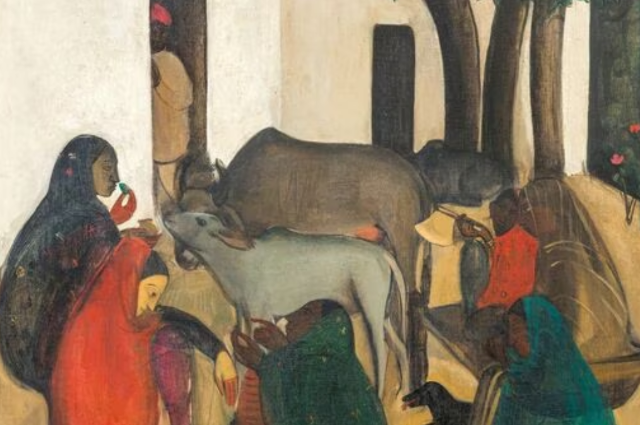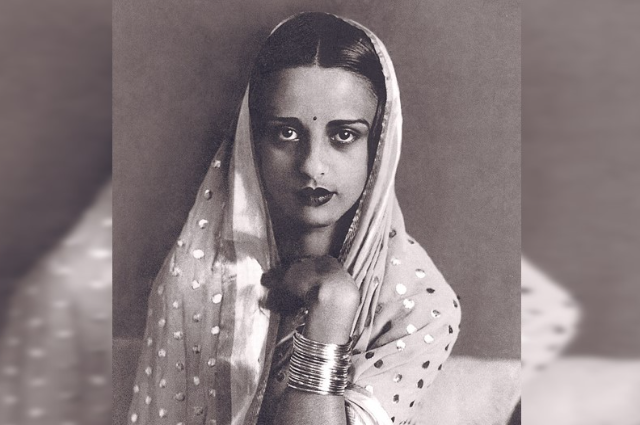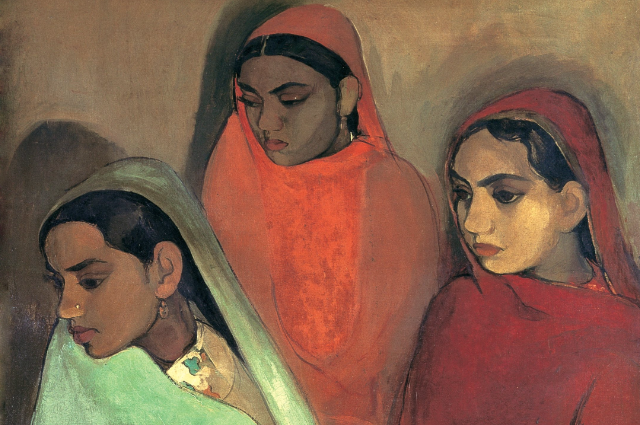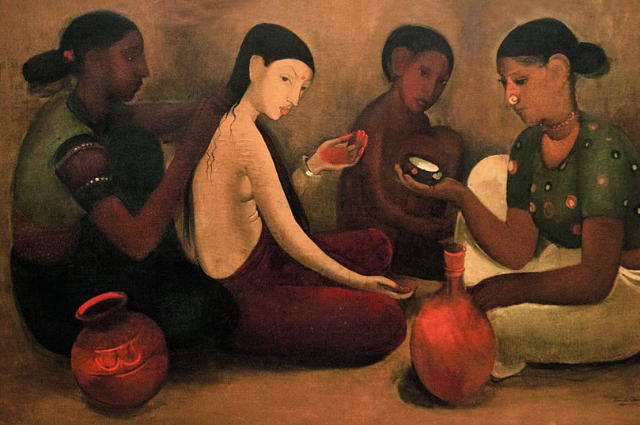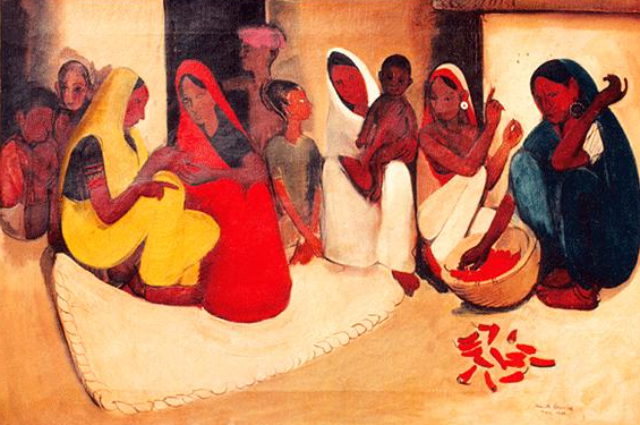Amrita Sher-Gil, a pioneering figure in the realm of Indian art, has left an enduring impact on the artistic landscape. Her legacy resonates with contemporary artists even today. Recently, one of her remarkable works, an oil painting titled "The Story Teller," achieved unprecedented recognition in the art world. This captivating masterpiece fetched a staggering sum of INR 61.8 crore at an art auction, making history the most expensive artwork ever sold in India. This milestone surpassed the previous record held by Sayed Haider Raza's "Gestation," which had sold for INR 51.75 crore just ten days earlier. The auction took place at The Oberoi in New Delhi and generated a total revenue exceeding INR 181 crore. The prestigious auction house SaffronArt orchestrated this historic event, not only organizing the sale but also securing the world record for the highest price achieved by an Indian artist.
The auction evening showcased a collection of 70 significant artworks, featuring creations by renowned artists like SH Raza, Akbar Padamsee, MF Husain, FN Souza, and VS Gaitonde, among others. Minal Vazirani, co-founder of the auction house, emphasized, "The sale of this particular work is a significant milestone in the art market. Equally important is the painting itself - it holds a unique place in Sher-Gil's body of work. She is a cherished national art treasure, and such works rarely become available for sale."
"The Story Teller" emerged during a phase in Amrita Sher-Gil's career when her artistic language seamlessly blended European and Indian influences. The painting prominently features women as its central subjects, reflecting her distinctive viewpoint as the lone successful woman artist in India. This achievement marked long-overdue recognition of her artistic brilliance. In "The Story Teller," Sher-Gil's unique artistic language harmoniously merges influences from the Pahari region and Paris, portraying a group of women at ease in an open setting, engrossed in their everyday activities.
Amrita Sher-Gil's artistic journey can be traced through her various artworks, with her earliest known creation, "Village Group," being auctioned in 1992, and her most recent work, "Untitled," finding a buyer in 2023. "Village Group" stands as one of her finest works, depicting a group of women and emphasizing Sher-Gil's commitment to placing women at the forefront of her canvases. Art experts praise her for the significant role her paintings play in highlighting women subjects, demonstrating her deep empathetic connection to their experiences.
Born in 1913 to a Sikh father and Hungarian mother, Amrita embarked on her artistic journey in Europe before making India her home. She made history as the first Asian artist to win a gold medal in painting at the prestigious Ecole des Beaux-Arts in Paris. Her portrayal of nudes in her art reflects her self-assuredness and mastery of her artistic skills, often using her sister and herself as models. Amrita Sher-Gil's art remains a testament to her pioneering vision and unwavering dedication to her craft.
Often likened to India's equivalent of Frida Kahlo for her ability to aesthetically blend traditional and Western art forms, Amrita Sher-Gil holds a prominent place in the annals of Indian art history. She is celebrated not only as a revolutionary woman artist but also as the progenitor of modern art in India. While her early works primarily depicted Western styles and culture, Sher-Gil gradually rediscovered her artistic identity by portraying Indian subjects using traditional techniques. Beyond painting, she possessed a talent for playing the piano and had a profound love for literature. Her extensive travels to different parts of India, France, and Turkey enriched her artistic perspective, allowing her to incorporate diverse ideas into her works.
Throughout her career, Amrita Sher-Gil painted her friends, and lovers, and created several self-portraits, a practice that some critics deemed narcissistic. In 1935, following her return to India from Europe, she produced "Three Girls," also known as "Group of Three Girls." In 1937, her painting was awarded the prestigious gold medal at the annual exhibition of the Bombay Art Society.
Interestingly, "Three Girls" was initially part of a collection sent to Nawab Salar Jang of Hyderabad, who ultimately declined all other pieces. The artwork features three women dressed in vibrant attire, pondering a destiny seemingly beyond their control. Sher-Gil's portrayal stands out for its absence of sensuality, presenting these women as individuals confronting significant challenges while displaying the resilience to transcend a fate they could not alter.
In 1938, Amrita Sher-Gil created the painting "Tribal Women," a departure from her usual portrayals of women marked by somber, oppressed emotions. This artwork radiates maternal warmth, evident in the mother's affectionate smile, and captures the innocence and vibrancy of youth in the daughter's blooming flower. The composition exudes tender and tranquil love, inviting viewers to appreciate its enduring beauty and timelessness. It serves as a gentle reminder of the softer and more nurturing aspects of human relationships, in contrast to the melancholic undertones often found in Sher-Gil's other works. During this period, "Bride's Toilet," a part of the South Indian trilogy, found inspiration in the classical tradition of the Ajanta murals. Amrita Sher-Gil depicted a large group of figures in this image, using a diverse and vibrant color palette to define them. During her extensive travels, Sher-Gil encountered the Ajanta Caves in the Aurangabad district of Maharashtra and the Mogul miniatures of South Indian culture, both of which left a lasting impression on her. Deeply dismayed by the neglect of art in India, she embarked on a mission to rekindle India's artistic fervor. She skillfully merged the frescoes of the Ajanta Caves and the Mogul miniatures into her European artistic training, resulting in remarkable works such as "Bride's Toilet."
Through her remarkable work, Sher-Gil holds the distinction of being the youngest and the only Asian artist to be elected as an Associate of the Grand Salon in Paris. Her work "Young Girls" earned her a prestigious gold medal in Paris, a remarkable achievement in that artistic hub. The Indian Government has also declared her paintings as National Art Treasures and most of her works now grace the halls of the National Gallery of Modern Art in New Delhi. Although her paintings remained largely unsold during her lifetime, they later commanded impressive sums, making her one of the most valuable Indian women painters of all time. Her other remarkable art piece "Village Scene" was sold for a whopping 6.9 crore in New Delhi in 2006. This painting sell also had a record as the highest amount paid for an Indian painting in India at that time.
Amrita Sher-Gil was not only one of the most impressive but also one of the most gifted Indian artists of the pre-colonial era. Her whole life was a colorful tapestry of freedom and exploration, where she embraced diverse relationships and even celebrated her bisexuality through her art, capturing the essence of her partners in her art. Today, Amrita Sher-Gil, a pioneer in Indian modern art, stands as one of the foremost avant-garde female artists of the 20th century. Her life and art continue to inspire and resonate deeply with art enthusiasts and scholars around the world. Her legacy, characterized by its intersection of cultures, its unwavering celebration of womanhood, and its fusion of traditional Indian influences with Western techniques, remains a testament to her genius. As her paintings grace the walls of museums and private collections, they not only serve as a visual testament to her brilliance but also as a poignant reminder of the cultural richness and artistic diversity of India.
. . .
Reference:

